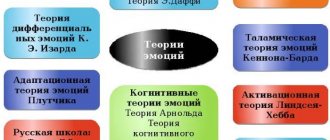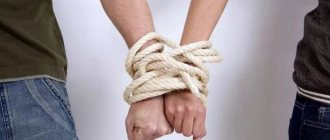We are accustomed to using the word “stress,” intuitively using it to denote strong neuropsychic tension. However, this meaning is not entirely correct. The mechanism of stress was studied and described in detail by Hans Selye, and the term itself was introduced by Walter Cannon.
Stress is the body's general response to various factors (for example, shock, hypothermia, infection, death of a loved one, job loss) that disrupt its balance. The main function of stress is adaptation to changed environmental conditions.
Thus, the emotional reaction is only part of the body's overall response to a stressor.
Factors that cause stress can be absolutely anything - both negative and positive (wedding, moving, new job). All that matters is that they lead to changes in a person’s life at one level or another. It is typical for a person to have stressors of a psychological nature: stress is caused not by the situation itself, but by how a person subjectively evaluates and perceives it. Or even a fantasy, a memory of some situation.
Types of stress
In medical practice, it is customary to divide stressful situations into two types: eustress - a positive form and distress - a negative form . Eustress mobilizes the body's vital resources and stimulates further activity. Distress brings psychological trauma, causes a “wound” that, even when completely healed, leaves scars.
Distress has a negative impact on a person’s physical and mental health and can give rise to the development of serious diseases. In a state of stress, the activity of the immune system is significantly reduced, and a person becomes defenseless against viruses and infections. With negative emotional stress, the autonomic nervous system is activated, and the endocrine glands work more intensively. With prolonged or frequent influence of stress factors, the psycho-emotional sphere deteriorates, which often leads to severe depression or phobias.
Based on the nature of the impact of stressors, the following are distinguished:
- neuropsychic;
- temperature (heat or cold);
- light;
- food (as a result of food deficiency);
- other types.
The outstanding psychologist Leontyev argued that in the case when the body demonstrates reactions to external phenomena that are not related to the satisfaction of vital needs (eating, the need for sleep, the instinct of self-preservation, procreation), such reactions are purely psychological. The concept of an intractable, extraordinary situation for a person in the concept of stress theory is also a psychological phenomenon.
Stressful situations are also divided into two groups: extreme social conditions (military operations, hooligan attacks, natural disasters) and critical psychological events (death of a relative, change in social status, divorce, exam). For some, the events that occurred are a shock, for others, they are a natural phenomenon, and the intensity of the reaction is purely individual. An indisputable fact: in order for a response to a stimulus to occur, this stimulus must have a certain strength. And each individual has an unstable, changeable threshold of sensitivity. An individual with a low sensitivity threshold demonstrates a strong reaction to a stimulus of low intensity, while an individual with a high sensitivity threshold does not perceive this factor as an irritant.
Biological and psychobiological stress
Stress is also usually divided according to parameters into two groups:
- Biological;
- Psychological.
Different authors have different definitions of psychological stress, but most scientists classify this type as stress caused by the influence of external (social) factors or formed under the influence of internal sensations. It is not always possible to apply the laws of the stages of its course to psycho-emotional stress, since each individual has purely individual mental properties and personal characteristics of the autonomic nervous system.
The control question allows you to differentiate the type of stressful situation: “Do stressors cause obvious harm to the body?” . In the case of a positive answer, a biological species is diagnosed; in the case of a negative answer, psychological stress is diagnosed.
Psycho-emotional stress differs from biological stress in a number of specific features, including:
- It is formed under the influence of both real and probable situations that are the object of the individual’s anxiety;
- Of great importance is a person’s assessment of the degree of his participation in influencing a problem situation, his perception of the quality of the chosen methods of neutralizing stressors.
The methodology for measuring stressful sensations (PSM-25 scale) is aimed at analyzing a person’s emotional state, and not at studying indirect indicators (stressor, indicators of depressive, anxious-phobic states).
Key differences between biological and psychological stress situations:
| Group | Biological stress | Psychological stress |
| Cause of occurrence | Physical, chemical, biological effects of stressors | Own thoughts, internal sensations, influence of society |
| Danger level | Real | Virtual, real |
| Direction of stressors | Somatic health, life-threatening | Emotional sphere, self-esteem, social status |
| Nature of response | “Primary” reactions: fear, fright, rage, pain. | “Secondary” reactions: excitement, restlessness, irritability, anxiety, panic, depression |
| Time range | Clearly defined within the boundaries of the present and near future | Unclear, vague, includes the past and an indefinite future |
| The influence of individual character traits | None or minimal | Essential |
| Example | Viral infection, trauma, food intoxication, frostbite, burn | Conflict in the family, separation from a partner, financial difficulties, change in social status |
What determines the degree and duration of a stress reaction?
How a person experiences stress depends not so much on objective as on subjective factors, on the characteristics of the person himself: how he evaluates the situation, compares his strengths and characteristics with what is required, etc. The cause of stress can be any unexpected event that disrupts the usual course of life. At the same time, the content of the situation itself is not so important. It is the subjective attitude towards it that is important.
Stressor is a factor that causes a state of stress. There are physiological and psychological stressors.
Physiological stressors – too much physical activity, temperature changes, pain, etc.
Psychological stressors are divided into informational and emotional. Information stress occurs when there is information overload. Emotional stress manifests itself in situations of threat, danger, anger, resentment, etc.
Among the events that affect the emotional sphere in terms of the degree of their impact we can distinguish:
- death of a loved one - 100 points, - divorce - 63, - imprisonment - 63, - death of a close family member - 63.
Pleasant events also cause stress:
- marriage or marriage - 50 points, - pregnancy - 40, - transfer to a new school - 20.
Research shows that among people who become ill as a result of stress, the vast majority score 300 points in one year.
Considering the above, stress cannot be associated solely with negative events. Tension can also arise in the case of positive, but sudden, unexpected changes.
Also, as psychologists note, we survive most big problems quite well, and attention should be paid to less dramatic stressors. The bustle of the day, petty everyday troubles (bad weather, an absent-minded neighbor, lost keys, daily trips to work by trolleybus or tram, rising prices) cause chronic stress.
People are more likely to be able to withstand acute and short-term stress. Problems arise when stress is prolonged: an unloved job, living with tyrant parents, constant petty conflicts in the family, etc. .
The American scientist Weitz described eight stressful situations:
- the need for accelerated processing of information
- harmful environment
- perceived threat
- impairment of physiological functions (possibly as a result of illness, insomnia),
- insulation
- imprisonment
- ostracism (expulsion and persecution)
- group pressure.
To these we can also add powerlessness, the inability to change the situation, the need to quickly change the strategy of behavior, making particularly responsible decisions, lack of control over events,
Factors that determine physiological susceptibility to stress include genetic (family) predisposition, age, experience, education, socio-economic factors and psychological characteristics of the individual. A significant role in the development of stress reactions is played by a decrease in the level of γ
-aminobutyric acid (GABA) is one of the inhibitory neurotransmitters of the brain.
In addition, the individual reaction to stress can be enhanced by maladaptive factors that are used to reduce internal stress, such as alcohol, drugs and nicotine. You can also add stress-related overeating and decreased exercise.
The effects of stress can be very different. The range of stress reactions is very wide - from lack of reaction to decreased quality of life (psychological discomfort, acute stress reaction, post-traumatic stress disorder, development of phobias, anxiety and panic disorders) to the development of severe pathology and death.
Stress: main stages of development
The range of reactions to a stressful event includes a variety of states of excitation and inhibition, including states called affective. The process of a stressful state consists of three stages.
Stage 1. Emotional reaction of anxiety.
At this stage, the body’s first response to stress factors appears. The duration of this phase is strictly individual: for some people, the increase in tension goes away in a matter of minutes, for others, the increase in anxiety occurs over several weeks. The body's resistance to external stimuli decreases, and self-control weakens. A person gradually loses the ability to fully control his actions and loses self-control. His behavior changes to completely opposite actions (for example: a calm, self-controlled person becomes impulsive, aggressive). The person avoids social contacts, alienation appears in relationships with loved ones, and the distance in communication with friends and colleagues increases. The impact of distress has a devastating effect on the psyche. Excessive emotional stress can cause disorganization, disorientation and depersonalization.
Stage 2. Resistance and adaptation.
In this phase, maximum activation and strengthening of the body’s resistance to the stimulus occurs. Prolonged exposure to a stress factor ensures gradual adaptation to its effects. The body's resistance significantly exceeds the norm. It is at this stage that the individual is able to analyze, choose the most effective way and cope with the stressor.
Stage 3. Exhaustion.
Having exhausted available energy resources due to exposure to a stressor for a long period of time, a person feels severe fatigue, devastation, and weariness. A feeling of guilt sets in, and signs of the anxiety stage appear again. However, in this phase, the body’s ability to readapt is lost, and the person becomes powerless to take any action. Disorders of an organic nature appear, and severe pathological psychosomatic conditions arise.
Each person has been “programmed” from childhood with their own personal scenario of behavior in a stressful situation, reproduced in frequency and form of manifestation of the stress reaction. Some experience stressors daily in small doses, others experience distress rarely, but in full, painful manifestations. Also, each person has an individual orientation of aggression under stress. One blames himself exclusively, triggering the development of depressive states. Another person finds the causes of her troubles in the people around her and puts forward unfounded claims, often in an extremely aggressive form, becoming a socially dangerous person.
Historical path concept
In the process of development, humanity acquired mechanisms that prevent the occurrence of stress reactions and promote an adequate response to stressors.
Systematic study of the functioning of the organism during its interaction with the external environment began relatively recently. In the mid-19th century, the French scientist Claude Bernard pointed out the constancy of processes and laid the foundations for the theory of homeostasis. To survive in a changing environment, the body needs all important functions to occur in a balanced manner with a minimum range of permissible changes. An imbalance can lead to devastating consequences, psychological and physical illness, and death. But nature has given the human body complex regulatory devices to control external stimuli.
Later, the theory of hemostasis was developed by Walter Cannon, pointing out the importance of the autonomic nervous system and hormonal regulation in adaptation.
In 1936, Canadian scientist Hans Selye proposed the concept of adaptation syndrome, which later became known as stress. An innovative feature of the concept was the discovery of the nonspecificity of internal reactions to stressful situations. A person reacts the same way to any stressor. Negative factors only trigger stress development mechanisms acquired over centuries of human existence.
Psychological mechanisms of stress
The emergence of emotional tension during stress is an adaptive reaction of the body that appears and grows as a result of the interaction of physiological systems and mechanisms in combination with psychological methods of response.
The physiological group of stress mechanisms involves:
- Subcortical system , which activates the cerebral cortex;
- Sympathetic autonomic system , which prepares the body for unexpected stressors, intensifies cardiac activity, and stimulates the supply of glucose;
- Subcortical motor centers that control innate instinctive, motor, facial, pantomimic mechanisms;
- Endocrine organs;
- Mechanisms of reverse afferentation , transmitting nerve impulses through interoceptors and proprioceptors from internal organs and muscles back to areas of the brain.
Psychological mechanisms are attitudes formed and recorded at the subconscious level, arising as a response to the influence of stress factors. Psychological schemes are designed to protect the human psyche from the negative consequences of stressors. Not all of these mechanisms are harmless; they often do not allow an event to be assessed correctly, and often harm the social activity of the individual.
Psychological defense schemes include seven mechanisms:
- Suppression. The main mechanism, the purpose of which is to remove existing desires from consciousness if it is impossible to satisfy them. Repression of sensations and memories can be partial or complete, as a result of which the person gradually forgets past events. Often it is a source of new problems (for example: a person forgets previously made promises). It often causes somatic diseases (headaches, heart pathologies, cancer).
- Negation. The individual denies the fact of the occurrence of any event and “goes” into fantasy. Often a person does not notice the contradictions in his judgments and actions, and therefore is often perceived by others as a frivolous, irresponsible, inadequate person.
- Rationalization. A method of self-justification, the creation of supposedly logical moral arguments to explain and justify socially unacceptable behavior and one’s own desires and thoughts.
- Inversion. Conscious replacement of true thoughts and feelings, actually carried out actions with completely opposite ones.
- Projection. The individual projects onto others, ascribes to other people his own negative qualities, negative thoughts, and unhealthy feelings. It is a mechanism of self-justification.
- Insulation. The most dangerous response scheme. The individual separates the threatening component, the dangerous situation from his personality as a whole. It can lead to a split personality and cause the development of schizophrenia.
- Regression. The subject reverts to primitive ways of responding to stressors.
There is another classification of types of protective mechanisms, divided into two groups.
Group 1. Patterns of disruption of information reception
- Perceptual defense;
- Crowding out;
- Suppression;
- Negation.
Group 2. Patterns of impaired information processing
- Projection;
- Intellectualization;
- Separation;
- Overestimation (rationalization, defensive reaction, exploitation, illusion).
Stress Management Mechanism
Mechanisms for coping with stress factors can be very diverse. The main goal of correcting the body’s behavior is to transform distress into eustress. Stress helped our ancestors survive, so why not now take advantage of its manifestations for your own benefit. The individual must realize that he needs to change the situation and his perception of what is happening. A person must understand that negative manifestations of stress are not the norm and require corrective work.
Corrective work is aimed at eliminating the stressor and working through perception. People who are often exposed to stress are usually sensitive natures and take everything to heart, often experience self-doubt, and are overly cautious.
To relieve stress, you need to use an integrated approach, which consists of several activities:
- correcting your attitude towards the stressor;
- neurolinguistic programming;
- strengthening the immune system;
- physical activity.
Stress factors
Stress levels are influenced by many different factors, including:
- The significance of stressors for an individual,
- Congenital features of the nervous system,
- Hereditary pattern of response to stressful events
- Features of growing up
- The presence of chronic somatic or mental pathologies, a recent illness,
- Unsuccessful experience in past similar situations,
- Motivation,
- Having moral principles,
- Stress tolerance threshold
- Self-esteem, the quality of perception of oneself as a person,
- Existing hopes and expectations – their certainty or uncertainty.
Causes of stress
The most common cause of stress is a contradiction between reality and an individual’s ideas about reality. Stress reactions can be triggered both by real factors and by events that exist only in the imagination. Not only negative events, but also positive changes in an individual’s life lead to the development of a stressful state.
Research by American scientists Thomas Holmes and Richard Ray made it possible to create a table of stress factors that, in most cases, have the strongest impact on a person and trigger stress mechanisms (stress intensity scale). Among the events significant for people:
- Death of a close relative
- Divorce
- Parting with a loved one
- Imprisonment
- Serious illness
- Job loss
- Change in social status
- Deterioration of financial situation
- Big debts
- Inability to repay loan obligations
- Illness of close relatives
- Problems with law
- Retirement
- Marriage
- Pregnancy
- Sexual problems
- The arrival of a new family member
- Change of place of work
- Deterioration of family relationships
- Outstanding Personal Achievement
- Start or end of training
- Change of residence
- Problems with management
- Unfavorable atmosphere in the team
- Changing your work and leisure schedule
- Changing Personal Habits
- Changing eating behavior
- Changing working conditions
- Vacation
- Holidays
Stress factors tend to accumulate. Without taking effective steps, pushing his experiences inside, being left alone with his problems, a person risks losing contact with his own “I”, and subsequently losing contact with others.
... and differences from physical
Physical and psychological stress differ in themselves and not only in the reasons for their occurrence and development, but also in their consequences. So, the reasons that provoke physical stress can be physical, chemical or biological factors, but psychological factors are more likely social influence, as well as one’s own thoughts.
Regarding the nature of the potential danger, a physical threat is provoked by a real threat, but a psychological one - such a threat can be both real and virtual.
With physical stress - a negative effect, its consequences are aimed at the health of the whole organism, organs and systems, and with psychological stress - on social status, level of self-esteem and other social parameters.
In relation to emotional experience, physical stress will manifest itself in the form of primary emotions, such as fear and pain, fright or anger, but emotional stress will manifest itself in the form of anxiety and depressive depression, anxiety and melancholy, jealousy or envy.
Regarding the issue of time frames, physical stress will manifest itself only in the present time or in the near future, having a specific frame, but psychological stress will have a vague time frame.
Psychological symptoms of stress
Manifestations of a stressful state are purely individual, but all signs are united by their negative connotation, their painful and painful perception by the individual. Symptoms vary depending on what stage of stress the person is in and what defense mechanisms are involved. Some of the main symptoms of stress include:
- Unreasonable anxiety;
- Feeling of internal tension;
- Hot temper, nervousness, irritability, aggressiveness;
- Excessive inadequate reaction to the slightest stimulus;
- Inability to control your thoughts and emotions, manage your actions;
- Decreased concentration, difficulty remembering and reproducing information;
- Periods of sadness;
- Depressed, depressed state;
- Decreased interest in usual activities, apathetic state;
- Inability to enjoy pleasant events;
- Constant feeling of dissatisfaction;
- Capriciousness, excessive demands on others;
- Subjective feeling of overload, persistent fatigue;
- Decreased performance, inability to perform usual duties;
- Depersonalization – detachment from one’s own “I”;
- Derealization - a feeling of illusoryness of the surrounding world;
- Changes in eating behavior: lack of appetite or excessive eating;
- Sleep disorders: insomnia, waking up early, interrupted sleep;
- Changes in behavior, reduction in social contacts.
As a result of exposure to stressors, an individual often tries to artificially replace the negative feelings experienced with “pleasant” external factors: he begins to take alcohol or drugs, becomes a gambler, changes sexual behavior, begins to overeat, and takes risky, impulsive actions.
Treatment of stress
When in situations that cause stress, each person should strive to emerge victorious from the current situation, to overcome obstacles courageously, with self-esteem and without negative consequences for health. After all, every new battle with stressors is another step on the thorny path of self-development and self-improvement.
Drug treatment of stress conditions
The choice of a comprehensive pharmacological treatment program is carried out on an individual basis, taking into account various factors, including:
- predominant symptoms, strength and frequency of their manifestation;
- stage and severity of the stressful condition;
- patient's age;
- somatic and mental health status of the patient;
- personal characteristics, way of responding to stressors, individual sensitivity threshold;
- a history of mental pathologies and borderline states;
- individual preferences and financial capabilities of the patient;
- the received therapeutic response to drugs used previously;
- tolerability of pharmacological agents, their side effects;
- medications taken.
The main criterion for prescribing treatment is the symptoms shown. To eliminate stressful conditions use:
- Tranquilizers;
- Beta blockers;
- Amino acids;
- Herbal sedatives, bromides;
- Neuroleptics;
- Antidepressants;
- Sleeping pills;
- Vitamin and mineral complexes.
If the patient has predominant signs of an anxious state (irrational fear, excessive worry, anxiety for no reason), a short-term course of treatment with psychotropic drugs is administered to relieve symptoms. Use benzodiazepine tranquilizers anxiolytics of other groups (for example: adoptol).
Beta blockers , the action of which is aimed at blocking the release of adrenaline into the blood and reducing blood pressure (for example: anaprilin), can quickly take control and minimize the painful physical manifestations of fear
In overcoming emotional stress, reducing nervousness and irritability, a good therapeutic response is provided by relatively harmless drugs containing aminoacetic acid (for example: glycine).
For mild manifestations of anxiety, sedatives from a “green” pharmacy made from valerian, mint, lemon balm, motherwort (for example: persen) are prescribed for a long course (at least one month). In some cases, drugs are used - bromides, which have significant sedative potential (for example: adonis-bromine).
If there are “defensive” obsessive actions in the disease picture, it is recommended to take antipsychotics - drugs that can eliminate severe mental conditions (for example: haloperidol).
When depressive symptoms predominate (apathy, depression, sad mood), antidepressants of various groups are used. For mild forms of depressive mood, a long-term course (more than one month) of herbal remedies is prescribed. Thus, drugs based on St. John's wort (for example: Deprim) will provide an antidepressant effect. In more severe and dangerous cases, psychopharmacological antidepressants of various groups are used. Selective serotonin reuptake inhibitors - SSRIs (for example: fluoxetine) are easy to use, do not lead to overdose and show high results. The latest generation of drugs, melatonergic antidepressants (the only representative of this class: agomelatine), can eliminate depressive symptoms and reduce anxiety.
If the patient notes a change in sleep patterns and quality (insomnia, early awakening, interrupted sleep, nightmares), sleeping pills , both herbal and synthesized benzodiazepine drugs (for example: nitrazepam) or new chemical groups (for example: zopiclone). The use of barbiturates as sleeping pills has lost its relevance today.
An important role in overcoming stressful conditions is to replenish the deficiency of vitamins and minerals . In situations of emotional stress, it is recommended to take B vitamins (for example: Neurovitan), products with magnesium (for example: Magne B6) or multiactive complexes (for example: Vitrum).
Psychotherapeutic techniques for overcoming stress
Psychotherapy for stressful conditions is a technique developed to provide a beneficial therapeutic effect on the psycho-emotional sphere of activity, directly related to and affecting the functioning of the human body as a whole. Psychotherapeutic assistance is often the only unique chance that allows a person in a stressful state to overcome existing problems, correct erroneous ideas and get rid of anxious and depressive states without negative consequences.
Modern psychotherapy uses over 300 different techniques, including the most common, popular and effective techniques:
- Psychodynamic;
- Cognitive-behavioral;
- Existential;
- Humanistic.
Direction 1. Psychodynamic approach
Based on the method of psychoanalysis, the founder of which was the famous talented scientist Sigmund Freud. Feature of the therapy: transferring into the area of consciousness (awareness) by the patient of memories, experienced emotions and sensations repressed into the subconscious sphere. The following techniques are used: study and evaluation of dreams, free associative series, study of the characteristics of forgetting information.
Direction 2. Cognitive behavioral therapy
The essence of this method is to inform and teach the individual the adaptive skills necessary in emotionally difficult situations. A person develops and maintains a new model of thinking, which allows him to correctly assess and act adequately when faced with stress factors. In artificially created stressful situations, the patient, having experienced a state close to panic fear, noticeably decreases the threshold of sensitivity to negative factors disturbing him.
Direction 3. Existential approach
The essence of therapy using this method is to concentrate on existing difficulties, reconsider the patient’s value system, realize personal significance, develop self-esteem and correct self-esteem. During the sessions, a person learns ways to harmoniously interact with the world around him, develops independence and awareness of thinking, and acquires new behavioral skills.
Direction 4. Humanistic approach
This method is based on the postulate: a person has unlimited abilities and opportunities to overcome problems in the presence of a significant incentive and adequate self-esteem. The doctor’s work with the patient is aimed at liberating the person’s consciousness, liberating him from indecision and uncertainty, and getting rid of the fear of defeat. The client learns to really understand and analyze the causes of existing difficulties, to develop correct and safe options for overcoming problems.
How to overcome the effects of stress on your own?
It is human nature to want to get rid of pain, tension, and anxiety. However, this ability to experience unpleasant sensations, oddly enough, is one of nature’s valuable gifts. A state of stress is a phenomenon designed to warn an individual about a threat to the integrity and vital functions of the body. This is an ideal mechanism that activates natural reflexes of resistance, evasion, retreat or flight, indispensable in the battle with a negative hostile environment. Unpleasant sensations accompanying a state of stress mobilize hidden resources, encourage efforts, changes and difficult decisions.
Every person needs to learn how to manage stress effectively and efficiently. If the event that caused the stress is dependent on individual activity (for example: emotional stress due to excessive work pressure), efforts should be concentrated on developing and analyzing options to change the existing situation. If an emotionally difficult situation is caused by external factors beyond the control and management of the individual (for example: the death of a spouse), it is necessary to accept this negative fact, come to terms with its existence, and change the perception and attitude towards this event.
Main types of stress response
Most often, a person’s response to environmental factors is a defense reaction and a defeat reaction. Defense reaction
occurs when a person is alert or busy with something.
Characterized by a period of struggle, it leads to a successful result. The defeat reaction
occurs in a person in connection with such emotional states as the collapse of plans or expectations, grief, sadness, despair, experienced shock (war, terrorism, etc.), when a prevailing feeling of fear, apprehension, anxiety and lack of hope for success solution to the problem. The defeat reaction is also called the depressive reaction or the helplessness reaction. A combination of a defense reaction and a defeat reaction is also possible.










